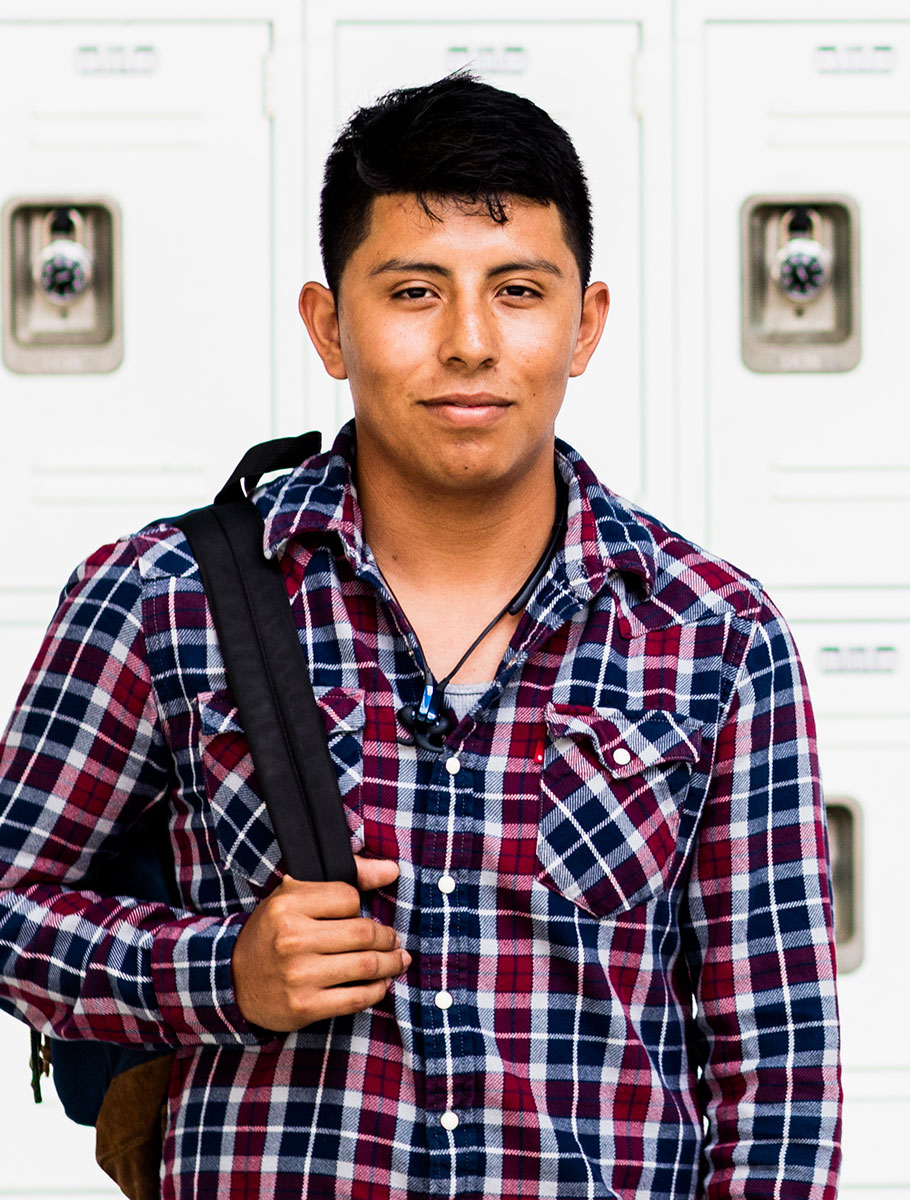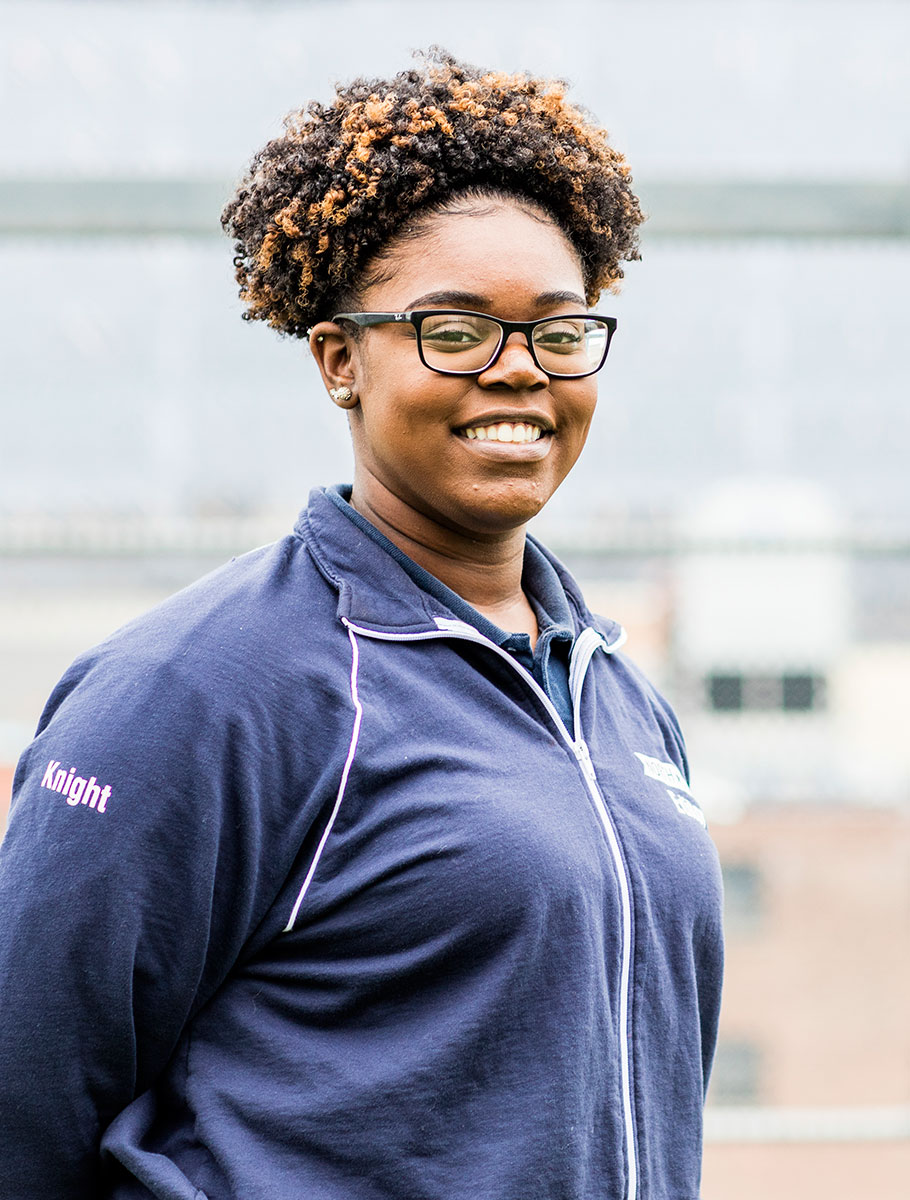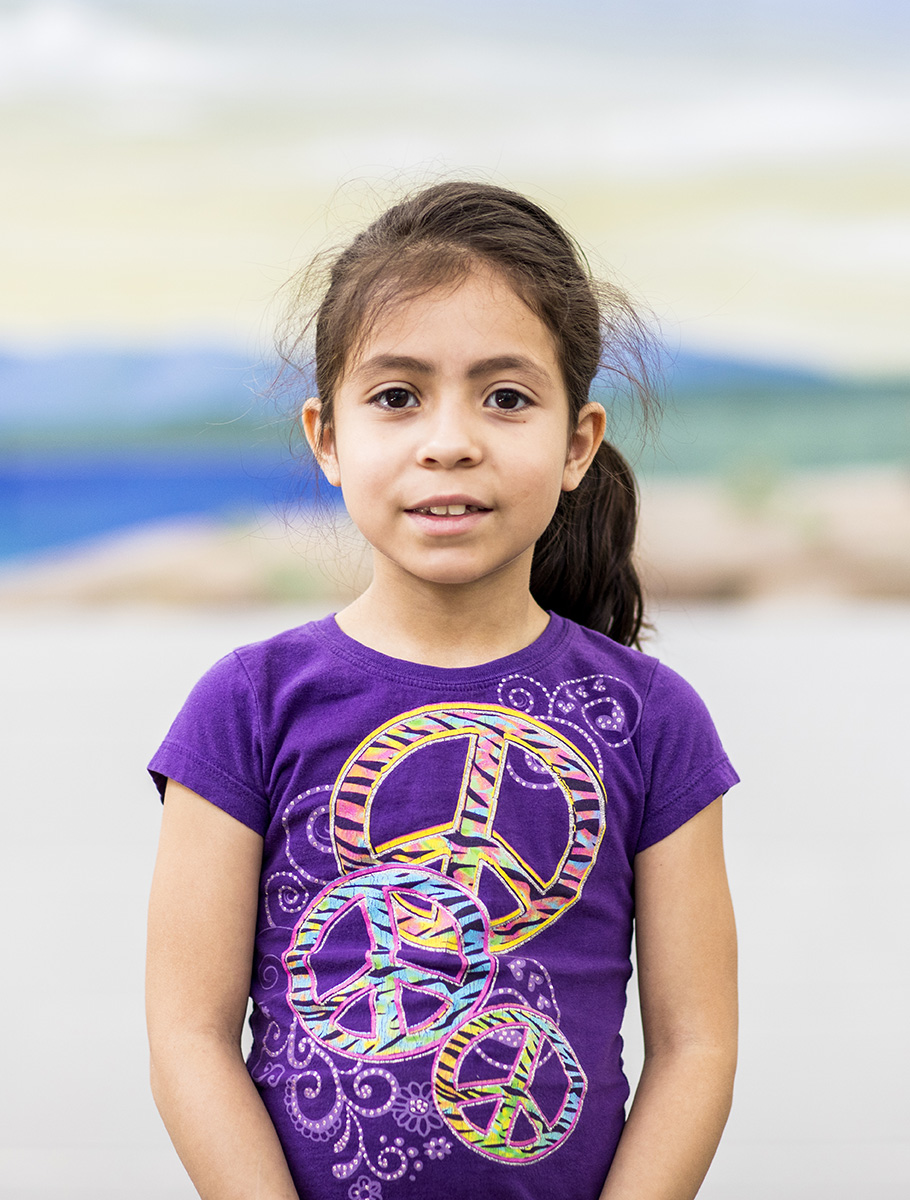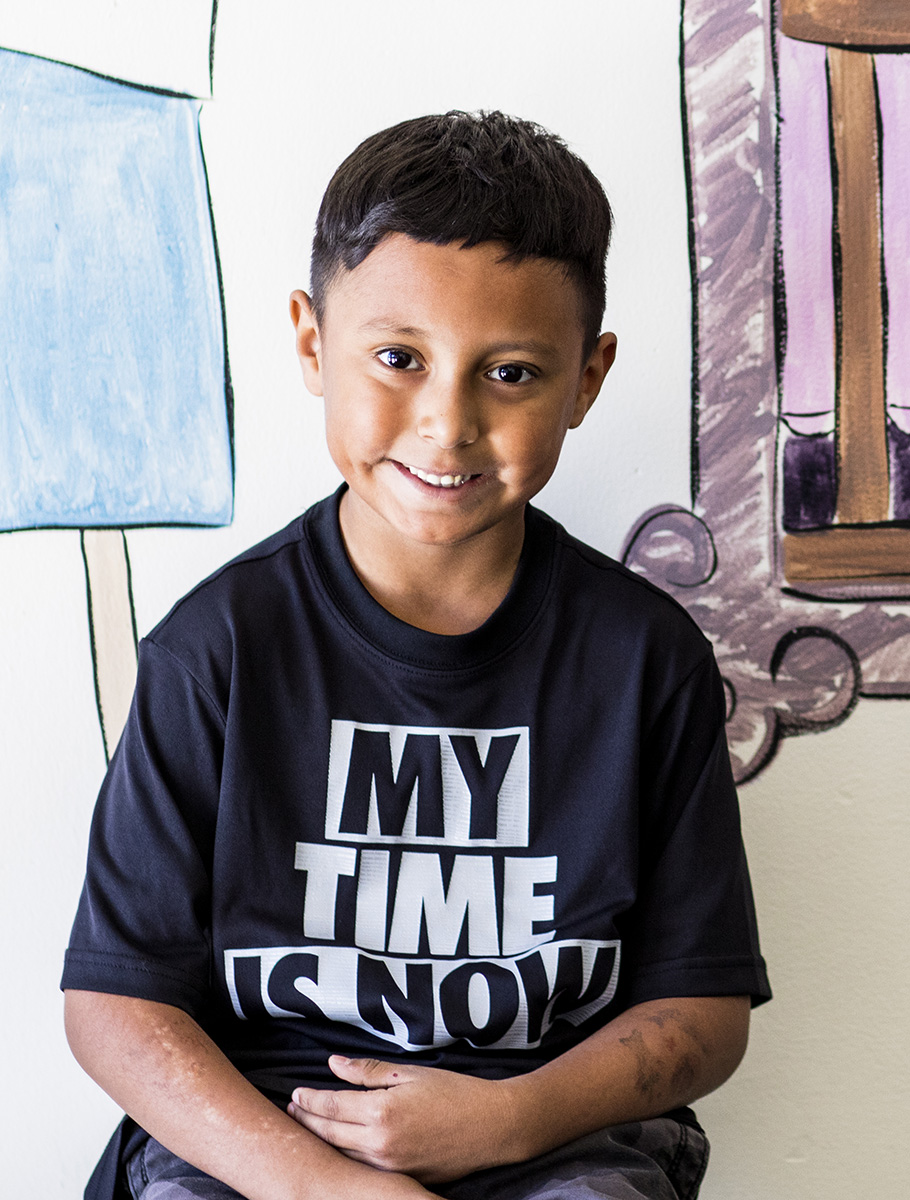Publication: Room to Run
Making History
Ashley’s Class | 6th Grade Science at Orchard Gardens K-8 Pilot School in Roxbury, MA
When Ashley Baez came to the United States from the Dominican Republic just two years ago, she spoke no English. “I was lost,” says Ashley, 11.
Today, Ashley is bubbling with excitement for the science she’s learning in Erin Dukeshire’s sixth-grade class at Orchard Gardens K-8 School in Boston. The class has sparked such curiosity, in fact, that she not only devours science content during school hours, but also watches videos of experiments at home.
“When I finish my homework, I go to YouTube and look at science experiments,” says Ashley, almost sheepishly. “I like the ones where you have containers with different liquids and then you mix them and they explode!” Ashley wants to be a doctor when she grows up—“the kind for babies.” She knows she’ll need to take many more years of science to get there. She’s up to the task.
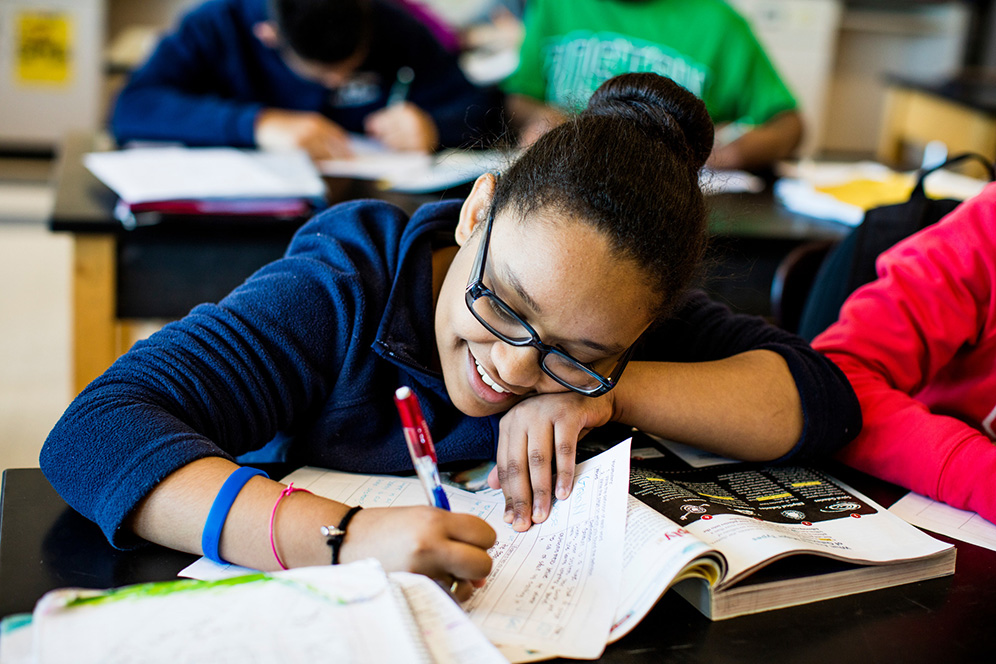
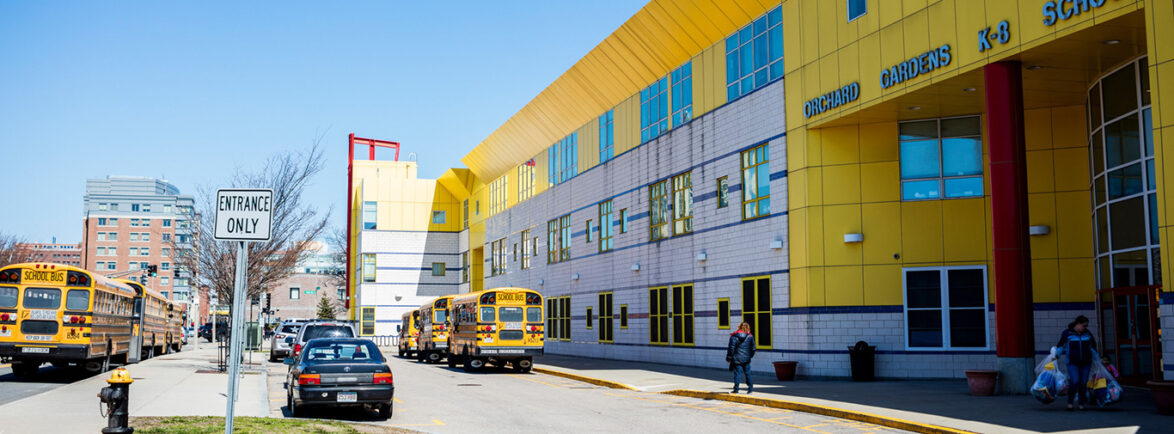
A Universal Language
It’s hard to tell that Roxbury, a neighborhood tucked in the geographic center of Boston, was once a farming community.
Today, low-rise housing complexes and aging multi-family homes line the narrow streets. Community centers, locally owned cafes, and arts venues are signs of a renaissance here, in a neighborhood that has struggled economically for years.
From Ms. Dukeshire’s classroom, her sixth graders can see the skyline of downtown Boston, with its modest skyscrapers and university buildings. For many Orchard Gardens kids, the promises of the city feel at once very close and very far away.
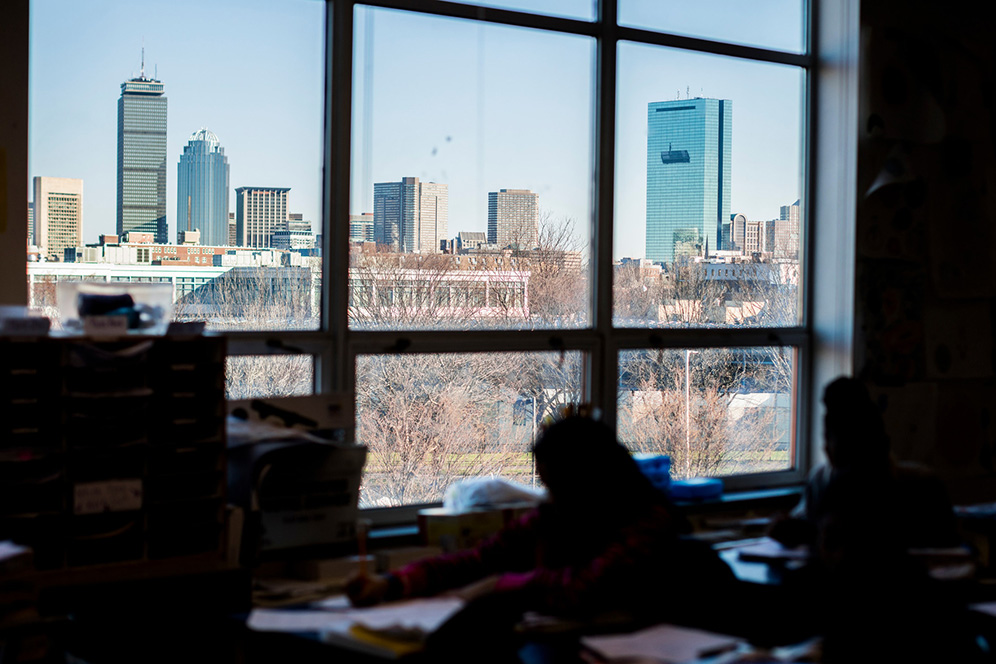
The view from room 337.
Until just a few years ago, Orchard Gardens was one of the lowest performing schools in Massachusetts. It’s made huge strides, while continuing to serve students with wide-ranging needs. Nine in 10 students here qualify for free or reduced-price lunch. Many of the school’s 800-plus students speak languages other than English at home: Spanish, Portuguese, and Cape Verdean Creole among them.
Here in Ms. Dukeshire’s science classroom, many students arrive with both limited English and limited prior knowledge of science. Some have come to the United States with little or interrupted formal schooling in their home countries. Others were born right here in Boston, but bring with them other learning challenges.
Too often, these students wouldn’t be expected to tackle the same level of content as their peers who are already working at grade level. They might be working with remedial texts. They might be copying science content off the board, even if they don’t know what it means. They might just be checking out entirely while their classmates forge ahead.
Not here. Ms. Dukeshire insists that every student, regardless of their background or proficiency in English, will develop strong content knowledge on key scientific concepts and facts. They’ll do that by focusing on the doing of science.
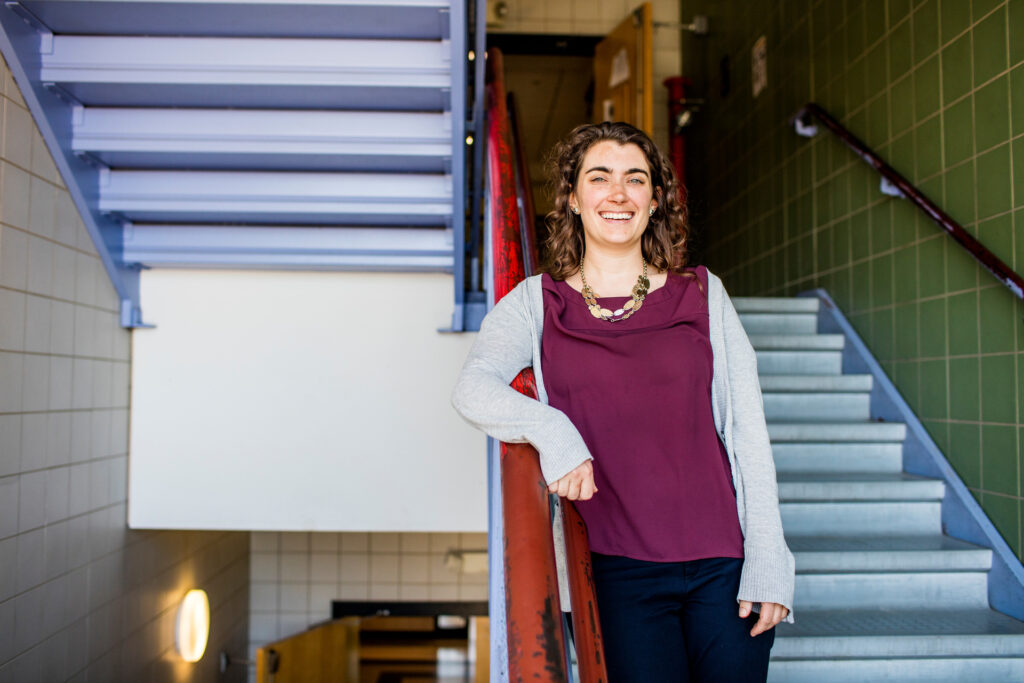
Erin Dukeshire at Orchard Gardens K-8 Pilot School.
The beauty of science, Ms. Dukeshire believes, is that the concepts are accessible regardless of language. She’s seen students with beginning language skills light up when given a data table—and immediately start making claims based on the data.
“To assume they couldn’t do the science because they don’t speak English doesn’t make any sense to me,” Ms. Dukeshire says. “I feel a lot of responsibility to make the work accessible to them.
To assume they couldn’t do the science because they don’t speak English doesn’t make any sense to me. I feel a lot of responsibility to make the work accessible to them.
– Erin Dukeshire
By giving her students ample opportunities to practice science—including grappling through tricky labs and making mistakes as they go—and by infusing her classroom with language supports and visuals, she is doing exactly that. Every day in room 337, students from the Dominican Republic, Cape Verde, Portugal, and elsewhere learn how to be scientists—and become more proficient readers, writers, and speakers of English along the way.
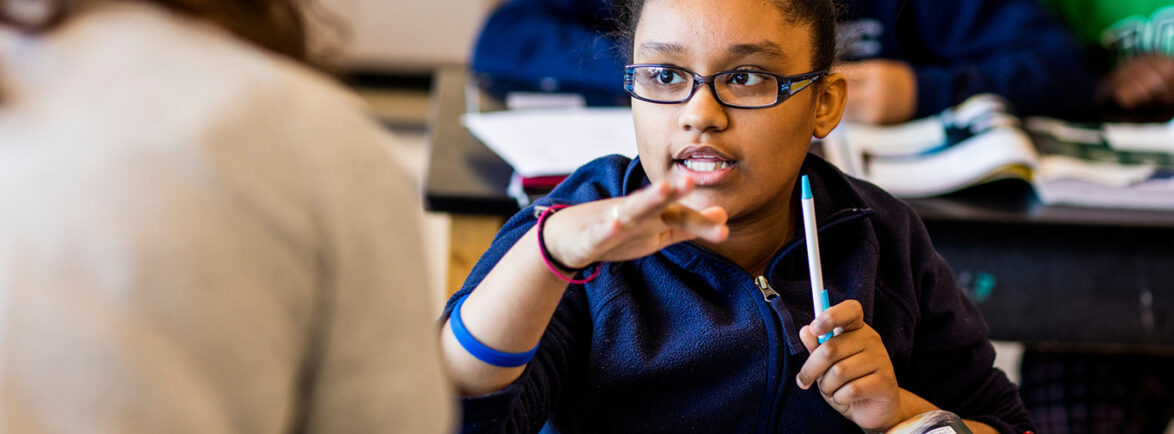
Training Scientists
At Ashley’s first school, out of state, she didn’t have the opportunity to practice much science, and the school did little to foster her engagement.
We didn’t have a lot of resources to do experiments. Science was boring,” she explains.
That’s not the case in Ms. Dukeshire’s classroom, where Ashley is learning fast. The practice of science helps develop her understanding—and it supports her English language skills, too, because it gives her a concrete understanding of concepts she’s also reading and writing about.
“We try an experiment and write down what happens,” she says. “You’re seeing with your eyes what’s happening.”
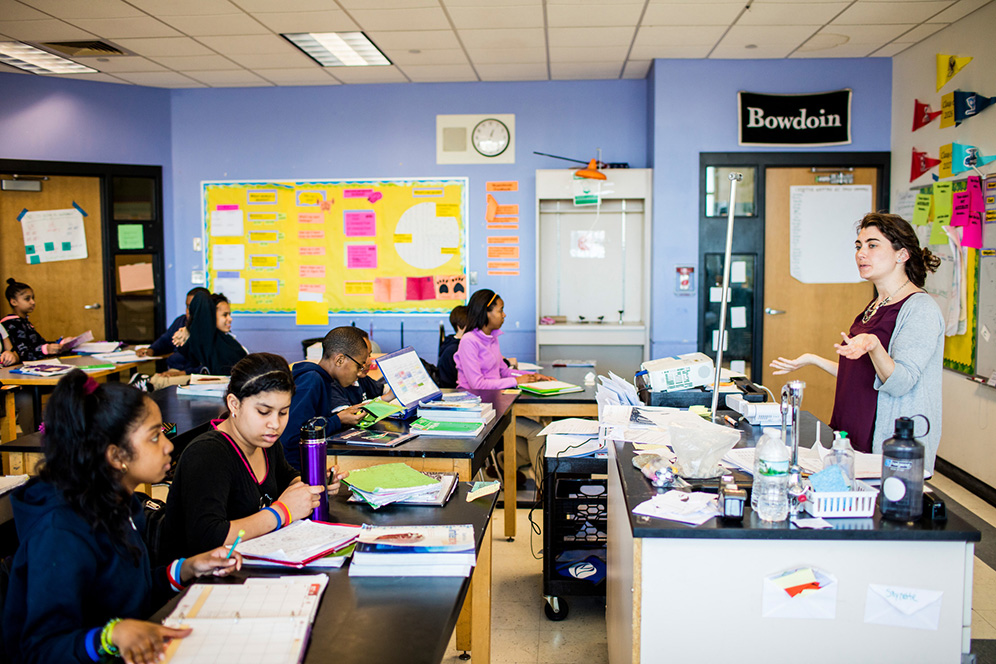
Many of Ms. Dukeshire’s students are new English speakers.
As the bell rings, Ashley and thirty-something fellow sixth graders find their seats around black lab tables, each labeled with a group name: Sulfur, Carbon, Phosphorus, Hydrogen. They are wrapping up a unit on matter.
Ms. Dukeshire opens class with a question: “What happens to the mass of an ice cube when it melts? If the mass of my ice cube is three grams, what will the mass of the water be?”
This could be answered by memorization, but Ms. Dukeshire isn’t interested in that. Instead, she’s after a much more fundamental idea: Regardless of the form of matter, mass doesn’t change.
“In this week’s lab, we melted eight different substances and observed what happened to the mass.” She draws a cube on the overhead projector. “What happens to the mass of an ice cube when it melts? Work with your partner and find evidence to back up a claim about this ice cube.”
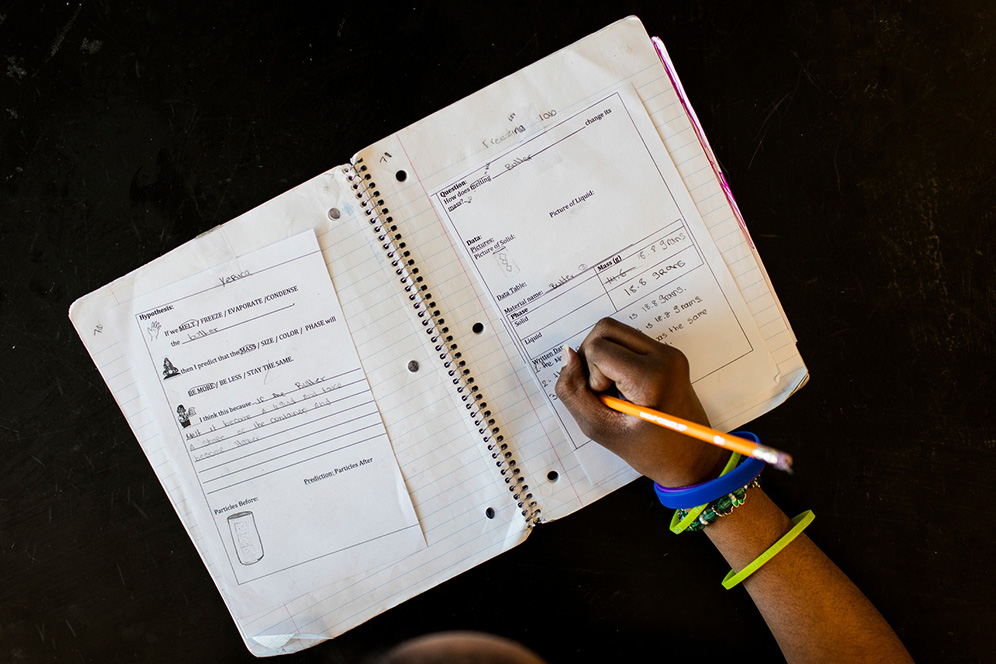
A student reviews her data from a lab on matter.
There’s some initial confusion. Where is the evidence to help them answer this question? Several students look to the textbook in front of them, but Ms. Dukeshire nudges them. “You have the evidence to answer this question. Where is it?”
With a gasp of recognition, one student pulls a bar graph from her notebook and waves it in the air.
“Yes! There’s your evidence! You collected this data.”
In the discussion that follows, students refer to their carefully drawn bar graphs about melted butter and chocolate to make a claim about the ice cube and challenge each other’s thinking. Instead of just explaining the answer, Ms. Dukeshire is asking her students to find it for themselves.
That’s what Ashley loves best in this classroom. She says she has a lot of questions about science; this year, she’s learning to answer them for herself.
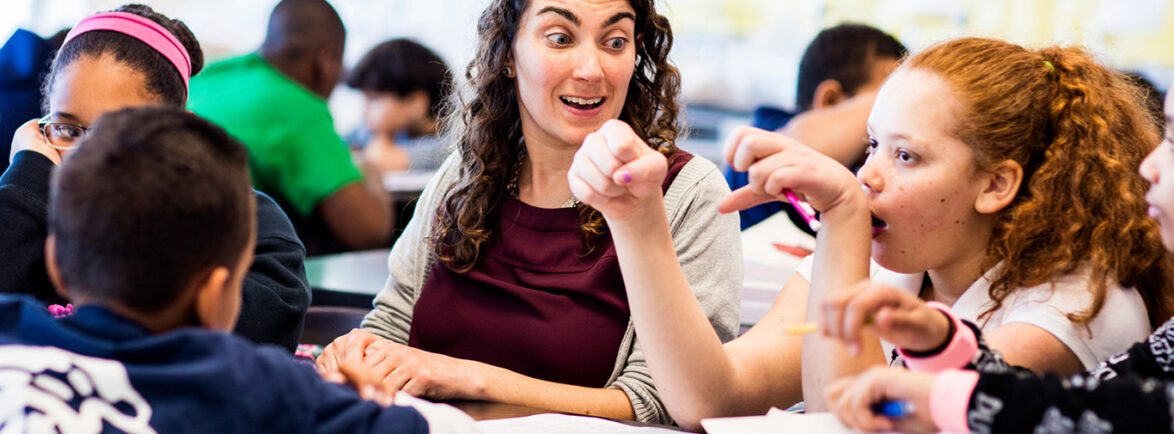
Real Science Is Messy
Putting more of the “figuring out” on her students is a shift in instruction Ms. Dukeshire has been making for a few years.
It’s been accelerated by Massachusetts’ 2016 adoption of more challenging science standards, which are tightly aligned to the Next Generation Science Standards. Both sets of standards aim to build a deeper conceptual understanding of science by encouraging the hands-on investigation used by practicing scientists.
This year, her eleventh in the classroom and sixth at Orchard Gardens, is the first time Ms. Dukeshire has taught exclusively to the new standards. It’s rewarding—and deeply challenging.
“In the last couple of years, I’ve been asking students to do more of the cognitively demanding work,” she says. “That needs its own set of lesson structures, and its own type of class culture to be able to ask students to do all of the hard thinking.”
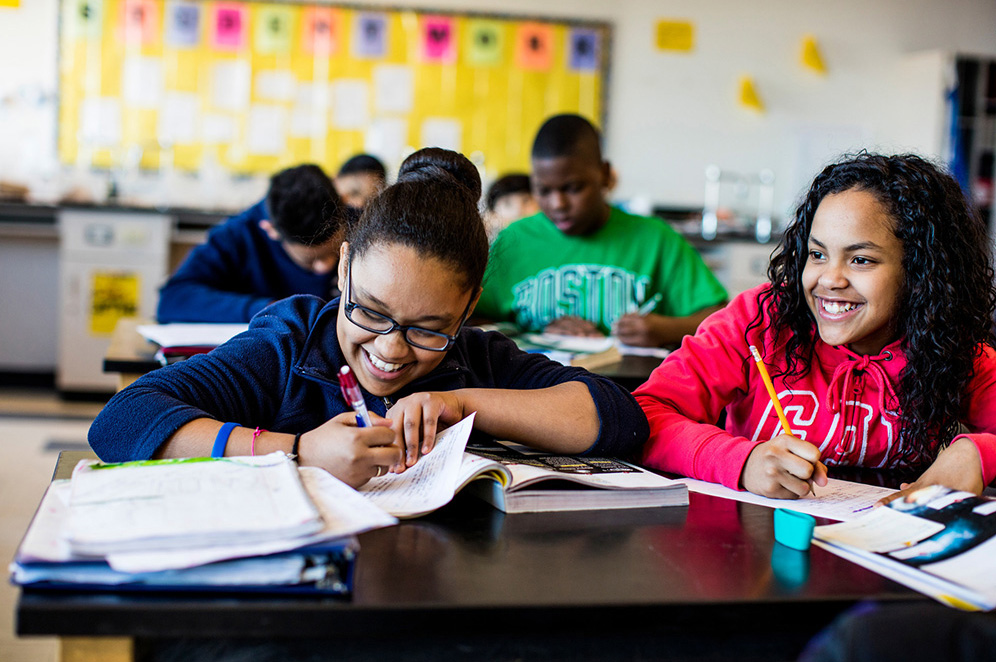
Science content in Ms. Dukeshire's class is challenging, but Ashley (left) and classmate Yesmarlyn Marte have fun tackling it.
They spent weeks in the beginning of the year learning to work productively in partners and then in groups of four. Ms. Dukeshire facilitated this by showing her class a video of students having an academic discussion in pairs. The class established norms for partner work based on what they observed, then did the same with group work a few weeks later. By spring, everyone was used to it.
Student-led work is just the start, though. Ms. Dukeshire has also shifted her approach to give students more freedom to figure things out on their own.
That means labs that are less prescriptive than the ones she used to have her students do—and in which they’re more likely to make mistakes. As students conduct experiments, they run into the same roadblocks—and errors—as real scientists, and the class has to take unexpected detours to figure things out.
In the lab on matter, for example, an error with the balances threw off some of the results. Students made the logical (but incorrect) conclusion that the mass of an object changes when it melts. It took an extra week of instruction to address the confusion.
By the end, though, students understood how the properties of matter played out in real life. They also uncovered this inconvenient truth of scientific practice: It’s imperfect.
“In the past, I just used a textbook or video to teach concepts where I knew that error in student-collected data could impact their understanding,” she says. “Now, I’m letting the kids do tricky labs and finding ways to teach the complications that arise from that, instead of just avoiding those and telling them what’s true. I want to let them get things wrong, let them struggle.”
The old way of teaching was easier, and Ms. Dukeshire is frank about that. “I haven’t yet figured out when is the right time to give them the correct answer—or even if I should,” she muses. “I don’t want them to think the mass of an object changes when it melts. But I also think there’s a ton of value in them figuring that out for themselves. At some point, you have to move on to the next unit.”
It’s clear that Ms. Dukeshire is in the process of grappling with the standards herself, alongside her students. “When you’re teaching new standards, sometimes the teachers are learning as much as the kids. We’re learning what they’re going to struggle with, and that informs how we teach it the next time.”
Still, Ms. Dukeshire is convinced that the struggle is worth it for her students, who she hopes will build a deeper understanding of the key concepts of science as a result. If it takes longer, or it’s messy and imperfect, that too is part of the learning process.
When you’re teaching new standards, sometimes the teachers are learning as much as the kids.
– Erin Dukeshire
“The more your K-12 education can align to what you’re going to do post-K-12, the better,” she says. “Kids are learning to synthesize information and make a model. That’s what scientists do.”
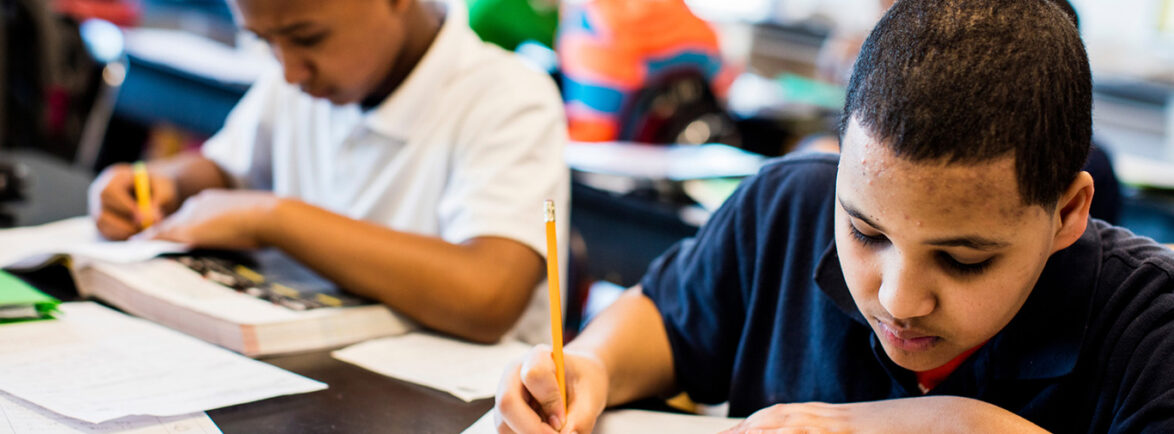
Don’t Be Shy
If hands-on science instruction is a path to unlocking complex science concepts for all students, it’s particularly important for Ms. Dukeshire’s English language learners.
On a proficiency scale from one to five, where five means fluency with social and academic language on their grade level, many of Ms. Dukeshire’s English language learners are at a level two. This means they know some social and academic English, but still rely heavily on visual and language supports for reading and writing.
So when students are reading, writing, and speaking on a scientific topic that has been made real and visual for them through a lab, they have more context for understanding the written and spoken language surrounding the topic. They’re bringing more to the table, and they’re learning more as a result.
João Brandão, 13, has learned a lot in this classroom—science, English, and more.
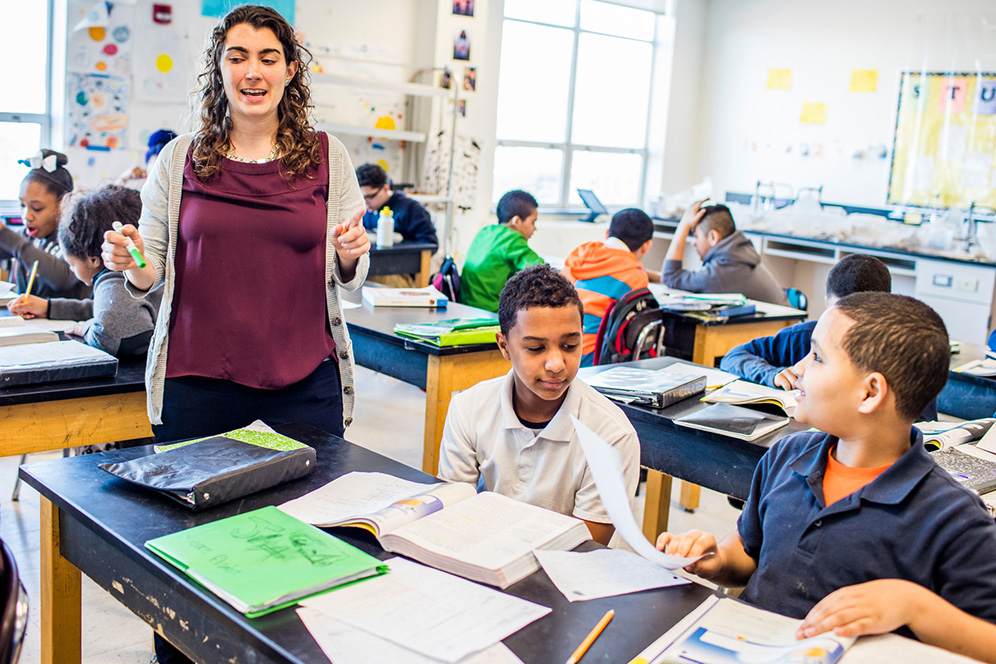
Ms. Dukeshire encourages her students to keep trying even when the work is hard.
If there’s one thing João misses about Cape Verde, it’s the mangoes—mangu, in his native Creole. He’s not much a fan of the weather in Boston, either. But he is a fan of his school.
João moved to the United States when he was six, leaving behind the small West African island chain to join his father and extended family in search of a better education for him and some of his nine older siblings. He arrived without knowing a word of English.
“I learned some English at home,” João says. “But reading—I didn’t learn that until I came to Orchard Gardens.”
His older cousin, Ildulce Brandão, who works at Orchard Gardens, says João has made tremendous progress in his new school, where he attends classes taught in English and also gets additional language support. That progress isn’t just academic; she’s seen his confidence grow, too.
“João is a bit of a shy kid, but he’s really come out of his shell,” she says. “I’ve seen him become a lot more confident in himself this year.”
João agrees. Now, when he doesn’t understand something in class, “I try to raise my hand,” he says. “Don’t be shy.” Ms. Dukeshire’s classroom is a safe place to ask his classmates questions. João likes that he and his classmates help each other understand the content.
“Ms. Dukeshire tells us two brains are better than one,” he explains. What about four brains? “Even better,” he says, smiling.
As they wrap up the unit, João is at ease explaining the three phases of matter: solid, liquid, gas. “And particles make up everything,” he adds. “Thousands and thousands of particles.” He didn’t have prior content knowledge on the topic, he says; it was all new to him. With his classmates’ support and a push from both his teacher and his older sister, João is excelling. Now, science is his second-favorite subject (after gym).
Down the road, João is certain he’ll go to college—not going isn’t even an option, as far as he’s concerned. One day, he’d like to become a chef. “I wish I could be just like Gordon Ramsay.”
José Pontes (left) and João Brandão look for evidence about particles and stars.
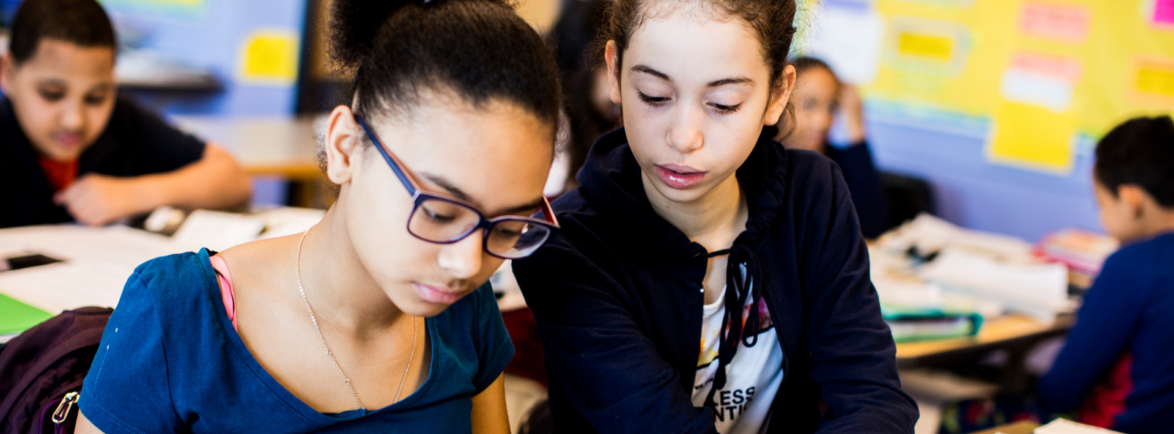
¿Qué Dice?
In Ms. Dukeshire’s classroom, the practice of science is building toward a bigger goal: that students—all students—can puzzle through challenging content, consider arguments and weigh evidence, and ultimately think for themselves.
None of that is easy.
On this March morning, the unit on matter now behind them, the students in room 337 are starting a fresh unit on earth and space. They’ll start with the foundational relationship between the earth and the sun and build up to modeling complex processes like lunar and solar eclipses.
They drop their backpacks by their seats and launch straight into the day’s “Do Now.” The Do Now is always a chant—with accompanying hand motions—that Ms. Dukeshire uses to reinforce key vocabulary for the current unit.
“Astro-no-mer, astro-no-my!” one student calls from his desk.
“Astro-no-mer, astro-no-my!” his classmates call in response.
“Tel-e-scope! A tool…to see things that are faaaar away!”
“Tel-e-scope! A tool…to see things that are faaaar away!”
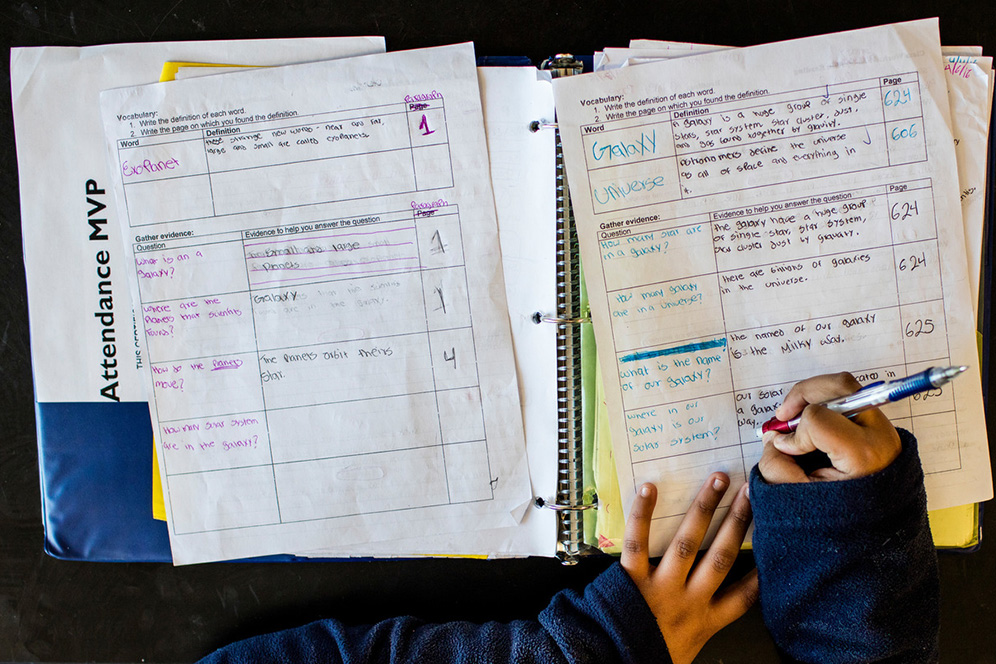
Ashley reviews vocabulary words for the earth and space unit.
With the Do Now finished, Ashley pushes her blue-rimmed glasses up the bridge of her nose and draws her group’s attention to the task at hand.
Ashley and her groupmates, Yesmarlyn Marte, 12, Angelica Herrera, 12, and Yerica Turbi, 13, are “all Dominicans, in this group,” Ashley says proudly. They use the text in front of them to find an early claim about the solar system (that the sun revolves around the earth), along with the evidence scientists once used to back up that claim. Then they’ll find an updated claim (that the planets revolve around the sun), along with its accompanying evidence.
Ashley and the girls use an orange sheet of sentence starters to support their English while they discuss the claims. They switch from English to Spanish, just as Ms. Dukeshire encourages them to do in order to maximize their understanding of the content in front of them.
“Mira,” Ashley says to Angelica, pointing to the text. “¿Qué dice?” What does it say?
There’s confusion at their table, and around the room. “I see a lot of hands up,” Ms. Dukeshire says, when she notices that a number of groups have stalled. “I know this is hard, but that’s not a reason to stop trying. You are all capable of doing this work. Keep making guesses.”
When Kanye Bailey, 12, gets stuck, he says his partner is the first person he turns to—not his teacher. That’s the culture of room 337—students supporting each other to figure things out—and Kanye says it works.
“If nobody’s really getting it, me and my partner will discuss it,” he says. “When you give somebody something difficult, they’re going to have to probably keep trying.”
As far as he’s concerned, that’s a good thing.
“Keep trying” is the theme in room 337. For the kids, it’s about making guesses when they get stuck, asking each other to explain their ideas, and returning to the evidence again and again. In Ashley’s group, the girls write their claims, discuss, erase, and rewrite.
For their teacher, the process is in some ways the same. Ms. Dukeshire is making intentional choices to build both science and language knowledge, but she’s also making educated guesses, testing one approach to give her students access to the content, then adjusting and trying something else as needed.
There are no straightforward answers here—just a lot of children with a lot of different needs, and a teacher feeling her way through a new kind of instruction that is asking more of both her and her students.
At one point, Ms. Dukeshire pauses momentarily to take a sip of water and a quick breath. She’s been darting around her classroom, addressing a hundred questions a minute, for the last three hours. She teaches five different groups, each with close to 30 students to a class, every day. Her energy is inspiring—but it’s also clear just how hard she’s working, every minute of every class period, to make sure all her students get what they need.
As Ashley and her group work on a poster of the galaxy, she uses Spanish to support her peers' understanding of the task.
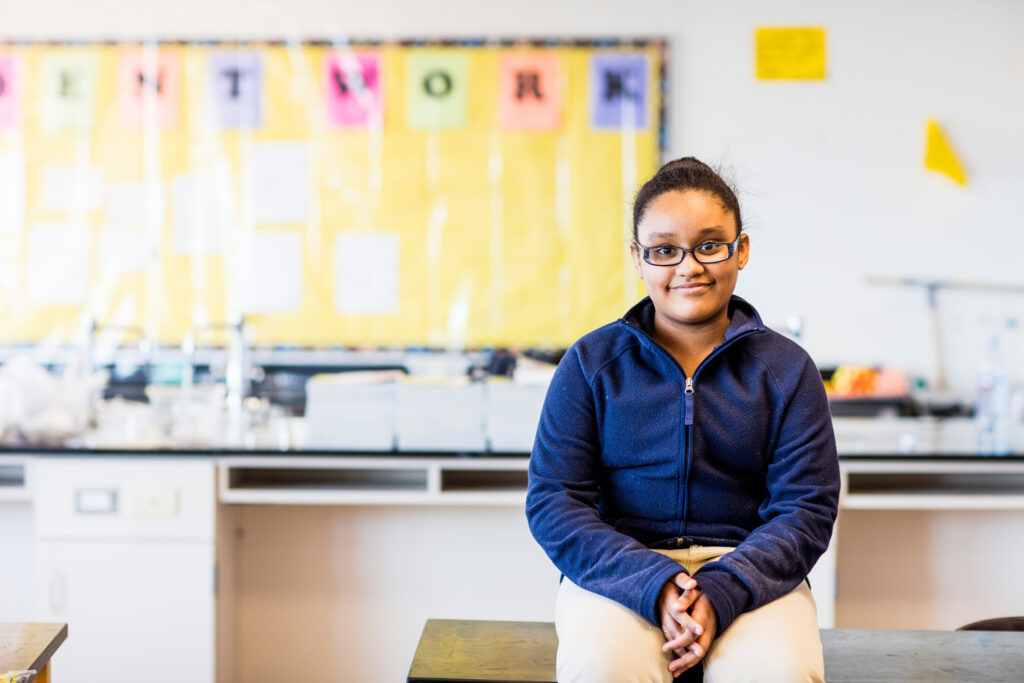
Ashley in her classroom.
That’s why I like science. Sometimes it’s hard. But once you practice, you get it.”
– Ashley Baez, 11
Two weeks later, the astronomy chant at the start of class is three times as long, as the group has extended their knowledge.
“Astronomy, astronomy, the study of space, astronomer!”
“Telescope! A tool to see things that are faaar away!”
“Claim! An answer to a question! Now give me some evidence to back up that claim!”
“Where’d you get your evidence? I got it from a source! I got it from a source!”
Ashley, Yesmarlyn, Angelica, and Yerica are reviewing their knowledge of the solar system by acting out a model of planetary rotation. Moons circle planets, which spin on their own axes while revolving around the sun.
Their understanding has come a long way since the lesson where they were flummoxed by the basics of the relationship between the earth and the sun. It hasn’t been easy, for the students or for their teacher.
But for Ashley Baez, that’s the point. “That’s why I like science,” says Ashley. ”Sometimes it’s hard. But once you practice, you get it.”
Her teacher agrees that if her students “get it” through practice, collecting and weighing evidence, and making models, that will be a bigger win than memorizing the phases of matter, or the name of our galaxy, or any particular fact.
“If I want to leave them with anything, it’s that scientists figure things out with data. It’s not true because I told you so.”
Read Another Student's Story
Stay in the Know
Sign up for updates on our latest research, insights, and high-impact work.
"*" indicates required fields
